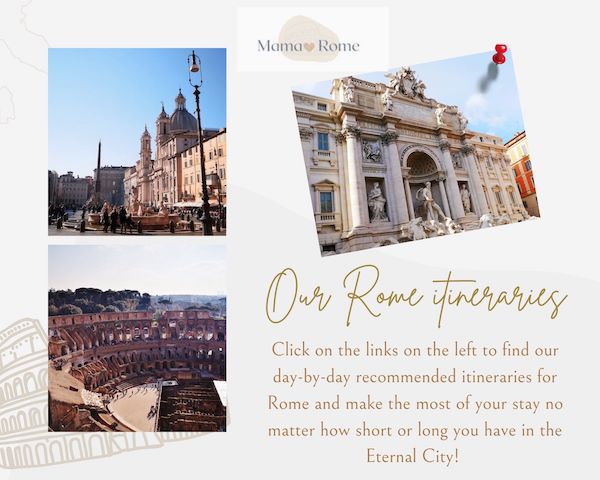All you need to know about the Fountain of the Four Rivers (Fontana dei Quattro Fiumi) in Rome: author, story, fun facts, tips for visiting.
The Fountain of the Four Rivers is one of the most famous fountains in Rome and one of the most photographed spots in the city.
Located in the center of famous Piazza Navona, the fountain is a masterpieces by architect and sculpture Gian Lorenzo Bernini and attracts everyday a plethora of visitors, who stay mesmerized by its unique beauty.
In a previous article, we have talked about Piazza Navona in general.
Today, we share fun and interesting facts about the Fountain of the four Rivers in particular, fun stories about it and a tips for visiting.
Safe travels!
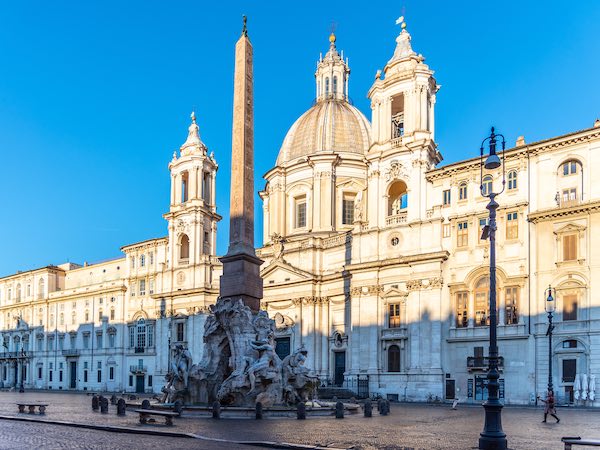
Fountain of the Four Rivers Facts
| Name | Fontana dei Quattro Fiumi / Fountain of the Four Rivers |
| Author | Gian Lorenzo Bernini (and disciples) |
| Client | Pope Innocent X |
| Date of construction | 1651 |
| Material | Travertine, Marble, Granite, Bronze |
| Water source | Acquedotto Vergine (Virgo Aqueduct) |
| Location | Piazza Navona, Rome |
Bernini’s fountain of the four rivers: quick history
In 1647, Pope Innocent X initiated a large project to upgrade and decorate Piazza Navona.
His family residence, Palazzo Doria Pamphili, was to overlook the square and he wanted the piazza to evoke the grandeur, elegance and powers of his family.
Gia Lorenzo Bernini wanted the commission. he had already worked extensively in Rome; however, he was close to the Barberini family, rival to the Doria Pamphili family, and was therefore far form the first choice for the job.
Instead, the preference seemed to have gone to Giovanni Borromini.
Bernini didn’t accept the situation and decided to go about the design competition with a trick.
He knew that Donna Olimpia Maidalchini, sister in law of the Pope, had a strong inlace on his decision (roomer has is she was the mind behind papa nominations in Rome). So Bernini though that the road to the Pope’s heart passed by her and decided to woo her with a present.
he made a silver model of the fountain he wanted to create and sent it to her personally.
Donna Olimpia loves the little model and convinced the Pope to give the commission for it to Bernini. The fountain has been in that location ever since!
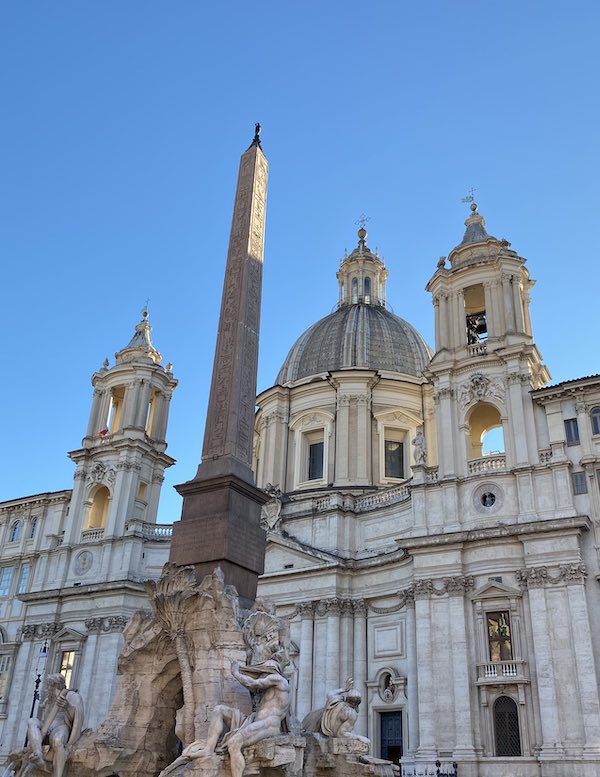
The statues of the Fountains of the Four Rivers
Bernini’s fountain takes its name from four large sculptures of main world rivers, represented as large male figures.
In Italian, its name is Fontana dei Quattro Fiumi. Each was sculpted by a Bernini scholar, following the drawing of the master.
Bernini himself seems to have sculpted the rocks and the horse.
The four rivers represented in Fountain of the Four rivers are:
The Nile – represented as a veiled man, sculpted by Giacomo Antonio Fancelli
Rio de La Plata – represented as a man with silver coins on its side, sculpted by Francesco Baratta
The Ganges – represented as a large man with an oar, sculpted by Claude Poussin
The Danube – represented with horses, sculpted by Antonio Raggi.
On top of the fountain stands an obelisk.
Let’s have a look at each statue.
The statue of the Nile
The statue representing the Nile is one of the most famous and recognisable on the fountain.
To symbolise the fact that the source of the Nile was unknown, the sculpture shows the river as a man with a veil over his eyes, hiding him from view.
The results is a statue with great evocative power!
Fun fact! Because of the rivalry between Bernini and Borromini, gossip spread the the reason why Bernini’s statue has a veil was because he didn’t want to see the eyesore of the church of St Agnes, made by his rival and towering over the fountain!

The statue of Rio de La Plata River
The statue representing Rio de La Plata and the Americas is distinctive and at at the center of another piece of Roman gossip.
Rio de la Plata is represented as a man, covering his face with a raised hand, as if frightened by something.
Since the statue faces the church of St Agnes by Borromini, gossips said Bernini wanted it in this position as if he was scared that the church would collapse on top of him.
In reality, it it more likely that the statue is in this pose as scared of a snake, carved beside him and representing the constant fear of the rich of losing their status.
Due to its peculiar and distinctive positions, this is one of the most famous statues in Rome.

The statue of the River Ganges
The Statue of the Ganges represents the continent of Asia and it is depicted as a tall male figure with an oar.
The oar represents the navigability of the Ganges, one of the main attributes of the river known at the time.
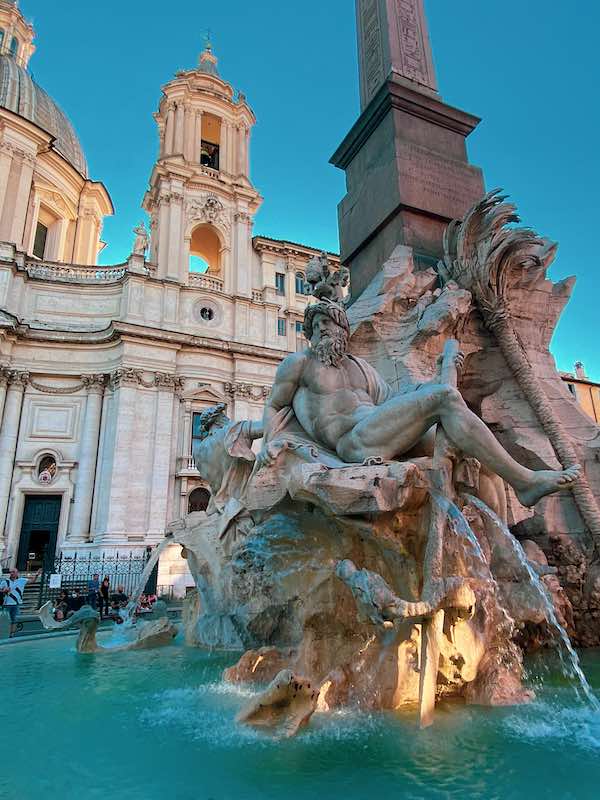
The statue of the River Danube
The statue of the river Danube is represented as a large male figure with running horses, to represent the large plains typical of Central Europe.
The River deity holds the coat of arms with the symbol of the Pamphili family, an inclusion typical of the sculpture of the time (see also the coat of arms on the Trevi Fountain or the Barberini’s on Barcaccia fountain).
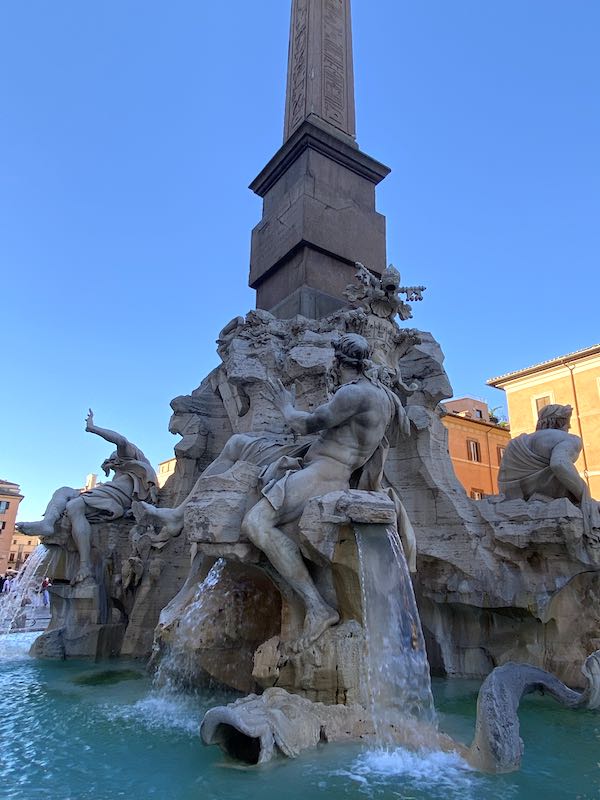
The obelisk on top of the Fountain of the Four Rivers
The Fountain of the Four Rivers as we see it now has the a main basin with the four sculpture of the River Personas and a tall obelisk on top.
The obelisk is one of the thirteen obelisks in Rome and it is an original Egyptian obelisk that came to Rome probably as decoration of the Serapeum (Tempe of Serapis) of Roman Emperor Domitian (I century AD).
The sides of the obelisk have Egyptian carvings and, on the top, there is a Christian cross, to symbolise the power of the Pope, victorious over all previous religions.
Animal Symbols on the Fountain of the Four Rivers
As well as the four dominant figures symbolising the rivers, several animals appear on Fontana dei Quattro Fiumi, each with their own symbolism.
Worth noticing are:
- The horses symbol of Europe
- The Crocodile symbol of Asia
- The Lion symbol of Africa
- the Armadillo symbol of Latin America
- The dove on top of the obelisk symbol of peace and evangelization
- The snake near Rio de la Plata, symbol of risk
Marine animals complete the scene.
Other fountains and attractors near the Fountain of the Four Rivers
On Piazza Navona, there are two other fountains, smaller than this one but nonetheless interesting: the Fountain to the Moor, which also incorporated elements by Bernini, and the fountain of the Neptune, also known as Fountain of Calderari (Fontana dei Calderari).
Also on the square you can admire the stunning church of Santa Agnese in Agone, the beautiful facade of Palazzo Doria Pamhpili, now using the Embassy of Brazil, and Palazzo Braschi, seat of the National Rome Museum.
Other fountains by Bernini in Rome
Bernini was a prolific sculpture and there are many more fountains in Rome by his hand.
Among the most famous it is worth remembering La Barcaccia Fountain on Piazza di Spagna (Spanish steps), and the two fountains in Piazza Barberini – all three showcasing the coat of arm of his most devoted client and protector: the Barberini Family.
You can also find here >>> List and locations of Bernini sculptures in Rome
How to visit the Fountain of the Four Rivers
The best way to see the Fountain of the Four Rivers in Piazza Navona is to come to the piazza on foot, either in the evening mid-week or early in the morning.
At this time, you can enjoy the fountain with smaller crowds.
Please note: entering the fountain is strictly prohibited at all times.
Not sure how to include this attraction in your Rome itinerary? Check our Rome itinerary suggestions below:
Rome in a day: detailed Rome city centre itinerary for first time visitors
Rome in two days A detailed itinerary for two full days in Rome
Rome in three daysRome in four days – day-by-day 3 day Rome itinerary
Rome in five days – complete Rome itinerary with main attractions and less usual sites for visitors with more time in the city
Traveling to Rome with kids? Find our family guide to Rome here.
